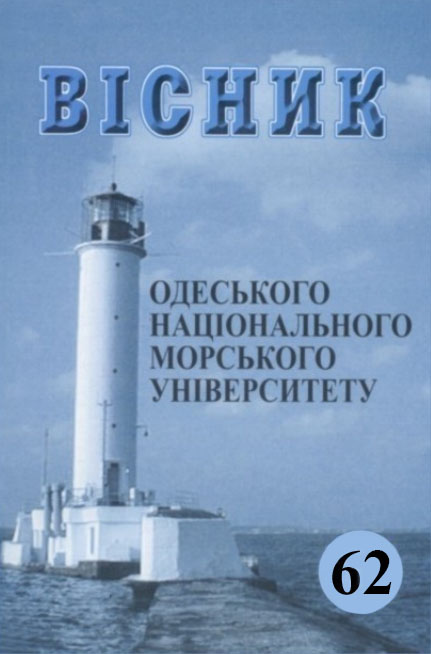Використання в суднових енергетичних установках технології гідродинамічної суперкавітації для розділення і очищення вод, що містять нафту
##plugins.themes.bootstrap3.article.main##
Анотація
Наведено аналіз існуючих даних з проблеми виникнення, зберігання, транспортування та сепарації вод, що містять нафту морських суден. Розглянуто компонентний стан забруднених нафтою вод як дисперсної системи. Зазначено, що методи, які забезпечують значення концентрації нафтопродуктів на виході з системи очищення менш ніж 15 млн-1, характеризуються складністю своєї технічної реалізації та великими витратами (економічними, енергетичними, матеріальними) на поточне обслуговування. Для розподілу вод, що містять нафту запропоновано варіант холодного кипіння рідини за рахунок використання гідромеханічного процесу суперкавітації всередині робочої камери. Показано, що застосування запропонованого способу очищення вод забезпечують залишкову концентрацію не більше ніж 5 млн-1. Доведено, що розроблена установка для сепарації суднових вод, що містять нафту характеризується малими енергетичними затратами та забезпечується стандартним комплексом робот на технічну експлуатацію, технічне обслугову-вання та ремонт.
##plugins.themes.bootstrap3.article.details##
Посилання
2. Kuropyatnyk, O.A., Sagin, S.V. (2019). Exhaust Gas Recirculation as a Major Technique Designed to Reduce NOх Emissions from Marine Diesel Engines. OUR SEA : International Journal of Maritime Science & Technology, vol. 66, no. 1, pp. 1-9. doi.org/ 10.17818/ NM/2019/1.1.
3. Malakhov, A.V., Kolegaiev, M.O., Brazhnik, I.D. (2018). Sover-shenstvovanie ekspluatacionnyh pokazatelej sistemy inertnyh gazov na tankerah [Improving the performance of an inert gas system on tankers]. Visnyk Xersonskogo nacionalnogo texnichnogo universytetu, no. 2(65), pp. 27-34.
4. Matskevich, D.V. (2013). Upravlenie reologicheskimi harakteristikami motornyh masel sudovyh dizelej [Management of the rheological characteristics of marine diesel engine oils]. Problemy texniky: naukovo-vyrobnychj zhurnal, no. 2, pp. 52-60.
5. Tkachenko, I.V. (2018). Ochistka neftesoderzhashih vod morskih sudov metodom gidrodinamicheskoj superkavitacii potoka [Puri-fication of oily water in ships by hydrodynamic supercavitation flow]. Universum: Technical science, no. 3(48), pp. 59-62. (in Russian)
6. Popovskii, A.Yu., Sagin, S.V. (2016) Ocenka ekspluatacionnyh svojstv smazochno-ohlazhdayushih zhidkostej sudovyh tehniches-kih sredstv [Evaluation of the operational properties of cutting fluids of marine technical equipment]. Avtomatizaciya sudovyh tehnicheskih sredstv: nauchno-tehnicheskij sbornik, no. 22, pp. 66-74.
7. Sagin, S.V., Matskevich, D.V. (2011). Opticheskie harakteristiki granichnyh smazochnyh sloev masel, primenyaemyh v cirkulyacionnyh sistemah sudovyh dizelej [Optical characteristics of boundary lubricating layers of oils used in marine diesel circu-lating systems]. Sudovye energeticheskie ustanovki: nauchno-tehnicheskij sbornik, no. 26, pp. 116-125.
8. Sagin, S.V., Zablotsky, Yu.V. (2011). Opredelenie tribotehnicheskih harakteristik poverhnostej po stepeni uporyadochennosti pristennyh sloev uglevodorodnyh zhidkostej [Determination of tribolo-gical characteristics of surfaces according to the degree of ordering of wall layers of hydrocarbon fluids]. Problemy texniky: naukovo-vyrobnychj zhurnal, no. 3, pp. 78-88.
9. Popovskii, A.Yu., Sagin, S.V. (2014). Kompleksnaya ocenka eks-pluatacionnyh harakteristik smazochnyh uglevodorodnyh zhidkostej [Comprehensive performance assessment of lubricating hydrocarbon fluids]. Avtomatizaciya sudovyh tehnicheskih sredstv: nauchno-tehnicheskij sbornik, no. 20, pp. 74-83.
10. Tkachenko, I.V. (2010). Metod otdeleniya vodnoj komponenty ot neftesoderzhashih primesej v sudovyh lyalnyh vodah, osnovannyj na gidrodinamicheskom processe superkavitacii [The method of separation of the aqueous component from oil-containing im-purities in ship's bilge waters, based on the hydrodynamic process of supercavitation]. Problemy texniky: naukovo-vyrobnychj zhur-nal, no. 3, pp. 59-70.
11. Kuropyatnyk, O.A., Sagin, S.V. (2018). Upravlenie vypusknymi gazami sudovyh dizelej dlya obespecheniya ekologicheskih pokazatelej [Controlling the exhaust gases of marine diesel engines to ensure environmental performance]. Avtomatizaciya sudovyh tehnicheskih sredstv: nauchno-tehnicheskij sbornik, no. 24, pp. 72-80.
